Church Furnishings and Windows, Part 3
North Wall (front to back)
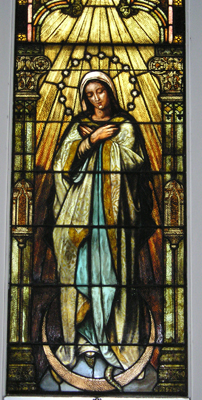
1. The Virgin Mary of the Immaculate Conception window (photo at left) portrays the Virgin standing on a crescent moon with a snake beneath her feet, a symbol of the Triumph of Virtue. Her gown is the traditional blue with a white and gold brocade (etched glass) cloak. The background is of golden-colored glass with petal-shaped tracery, as if to imitate a sculpture in a niche. Her dress and stance on the crescent moon refer to the woman clothed with the sun and with the moon under her feet (Rev. 12:1). Mary, as the Virgin of the Immaculate Conception, wears a crown of twelve stars. The number twelve is charged with Christian meaning and could symbolize the apostles or the twelve tribes of Israel. The style is similar to the first two windows on the south side. The Feast of the Immaculate Conception is celebrated on December 8.
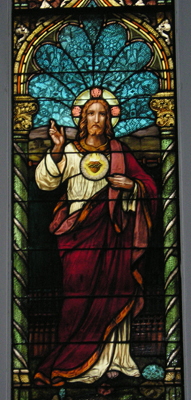
2. The Christ of the Sacred Heart window (photo at right) shows Christ standing and dressed in a white robe in a frontal pose to reveal his flaming heart. The background is minimal. The Feast of the Sacred Heart is celebrated the Friday following the Second Sunday after Pentecost. The Christ of the Sacred Heart is possibly a Meyer window.

3. The Presentation in the Temple window (photo at left) is another narrative window. The story of the Presentation of Christ in the temple is depicted. Mary stands to the left. St. Francis, highly devoted to the Infant Christ, mysteriously appears to give homage along with Simeon, who holds the Christ Child. Simeon lifts his head heavenward as he recites the Nunc Dimittis, indicating his recognition of the Child as the Savior. The fanciful architectural setting features two purple serpentine columns, a reference to the Temple of Solomon and to St. Peter’s Church in Rome.
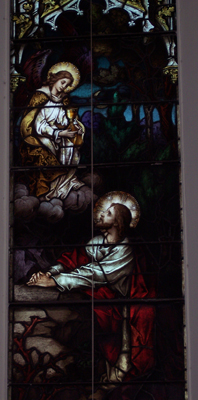
4. The Agony of Christ in the Garden of Gethsemane window (photo at right) is also a narrative window. The story of Christ praying in the Garden of Gethsemane the night of his arrest as his apostles slept is portrayed. Christ is depicted in the lower center in a seamless white gown and red cloak kneeling in prayer. He faces left, raising his eyes to see an angel holding a golden chalice slightly above and to the left. The chalice bears the monogram IHS. Standing for In Hoc Signum or “in this sign,” IHS is also an abbreviation for the name “Jesus” in Greek. The city of Jerusalem is depicted as a silhouette against the dark blue sky. A low crescent moon indicates the evening hour. This event is included among events of the Passion of Our Lord observed on Good Friday and included among the Stations of the Cross. The style of this window appears to be unique.
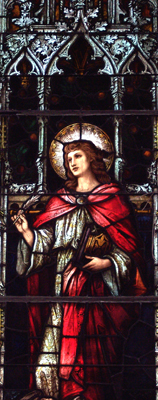
5. The St. John the Evangelist window (photo at left) honors St. John, the youngest of Christ’s apostles and the favored one. He is the author of the Gospel of John as well as three epistles and the Book of Revelation. He is depicted here with his emblem, the eagle. The Feast of St. John the Evangelist is December 27. The St. John window is a Meyer window.
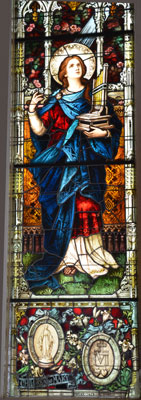
6. The St. Cecilia window (photo at right) highlights the patron saint of music, St. Cecilia (Third Century). She is depicted holding a small organ, a musical instrument which she is credited with inventing. Her feast day is November 22. St. Cecilia’s window completes the windows executed by Meyer.
